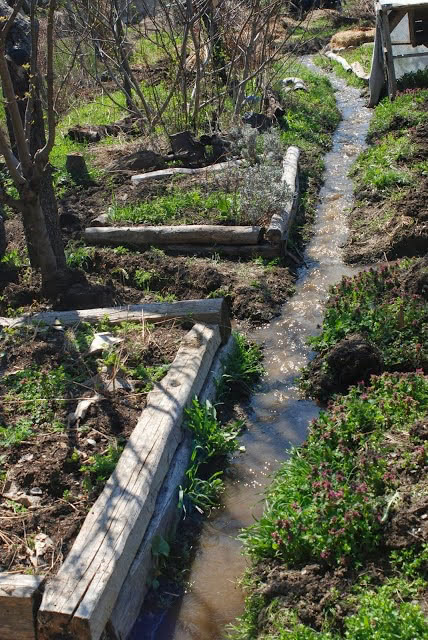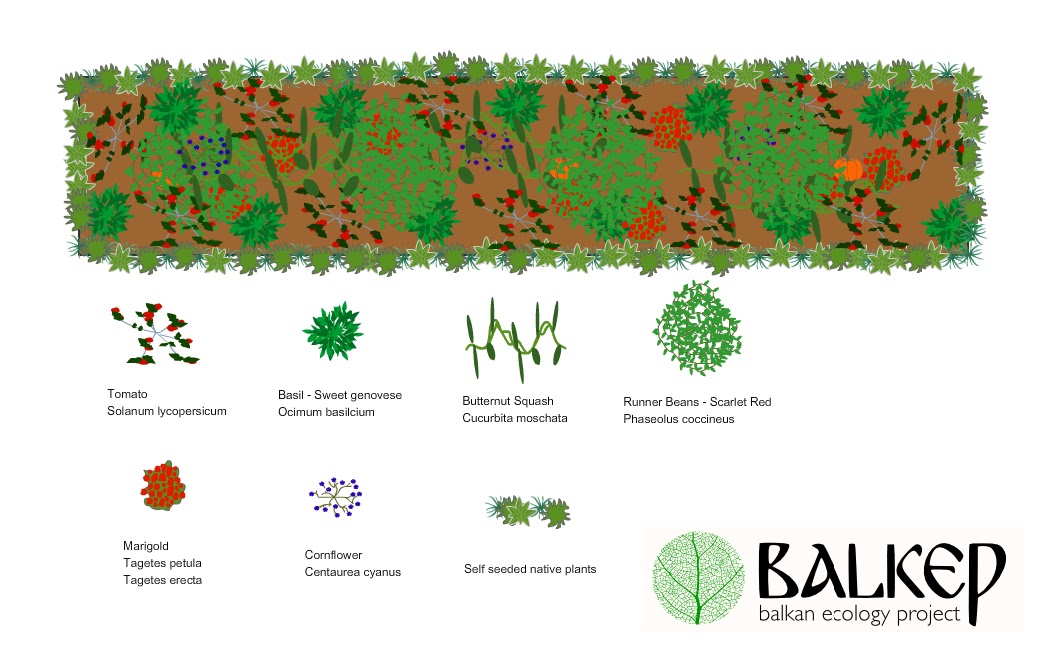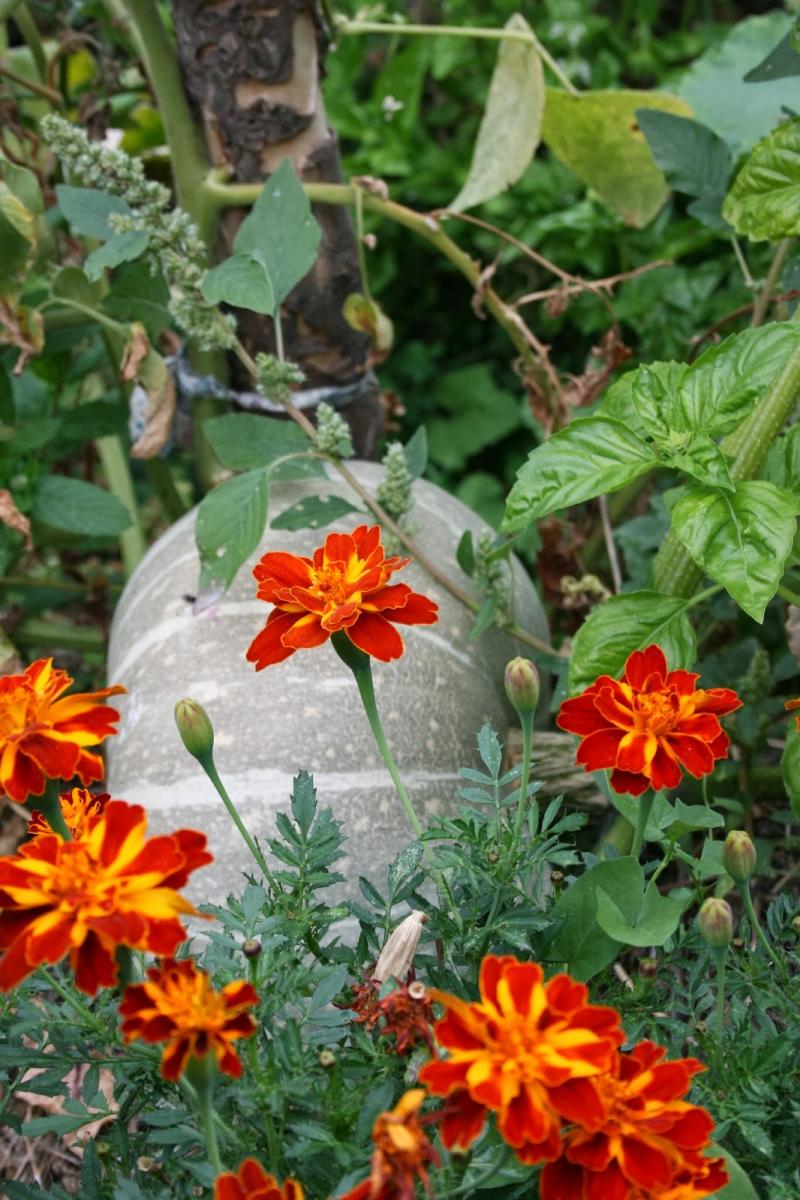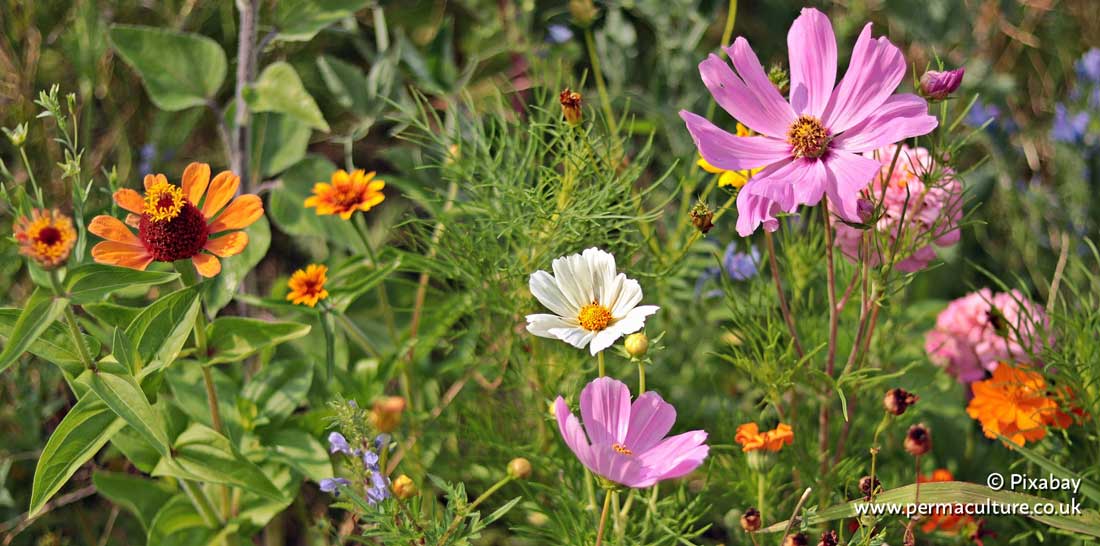For the last eight years we have been experimenting with growing annual vegetables and herbs in guilds. Over the years I have stuck with what works, discarded what has not, and now have what appears to me to be a good model of productive ecological design. Productive in that it provides us with a harvest from early spring until early winter, ecological in that it provides habitat and food for many other organisms too.
Our annual vegetable and herb guilds are situated in six raised beds each 1m x 6m and approx 30cm high with 50cm paths between the beds. Surrounding the beds are a diversity of perennial plants including herbs, shrubs and trees with some small ponds and various micro habitats such as rock piles, old tree stumps and stick piles. These six beds are dedicated to annual herb and vegetable production and are the most intensively cultivated areas in the garden providing us with the majority of our annual vegetables.
The 1m x 6m bed dimensions enable access to the soil and plants without ever having to tread on the beds. The beds are laid out on contour, lengthwise running east to west. This provides the plants within the beds with the maximum amount of sunlight and determines that rainfall will collect on the northern side of the bed and permeate into the soil slowly rather than draining away. This layout also enables us to flood irrigate the beds.
We are fortunate to have access to water channeled from a nearby mountain stream. When needed, we can divert the water into the garden where it flows along the paths between the beds. We raise the water level to 15-20cm in any particular bed by simply placing a barrier (sack filled with sawdust) at the end of a bed. The water is absorbed into the soil and can travel vertically via capillary action.

(Paths/irrigation channels in the garden)
In the early spring when the temperature starts to rise we place a 1m x 3m bottomless chicken coop, with eight hens inside, onto one half of a bed. The chickens will stay there for 3-4 days and each day we throw them in kitchen scraps, grain, straw and a few shovels of compost. The chickens will relentlessly scratch among the soil and mulch picking off the eggs of slugs and larvae, pupae of various arthropods. This helps to keep pest populations down. They also forage for seeds in the soil and thereby reduce the emergence of undesirable plants in the bed. The chicken’s scratching mixes up the organic matter we throw in daily and the birds contribute a ready supply of droppings as they go.
After three or four days we move the chickens onto the next half of the bed and the process repeats. The area cleared is soaked well (or we wait for rain) and then mulched with a few buckets full of compost and a 20cm layer of straw mulch (approx 3/4 of a bale). The mulch provides a good habitat for toads and lizards (in the spring, summer and autumn) which are well positioned to pick off any slugs that venture in for the young seedlings.
Once mulched the stakes for tomatoes and beans are put into position. Large reliable germinating seeds such as beans and squash are sown directly into the beds by pulling back the mulch and sowing into the soil. The other plants (see below) are reared in pots and planted into the beds when approx 15cm tall and when the weather is suitable. Any ‘weed’ plants that grow around the edge of the beds are cut back before they set seed and used as additional mulch throughout the year. ‘Weeds’ that grow within the bed are treated the same way. Note that the ‘weeds’ are not uprooted only cut to ground level. The roots are allowed to decay in the ground or left to regrow until they are again ready to ‘chop and drop’.
Around July the vegetable and herb plants are all well established with little room for ‘weed’ plants to establish. The attention the beds require after July is mainly irrigating and harvesting until October. When the last of the harvest is out of the beds the stakes are removed and the chickens are brought in for another 3-4 days to pick through the vegetation. None of the plant material is removed from the bed, what the chickens leave behind is cut into small pieces and applied to the surface as an overwinter mulch.
The plant selection differs slightly from bed to bed; all feature tomatoes, beans, basil and squash. Below is a representation of one planting scheme that shall be the focus of discussion here.

(Representation of Annual Vegetable and Herb Guild)
This guild consists of 11 tomato plants (a different cultivar is usually planted in each bed) on the edge of the raised bed for easy picking and to be in close proximity to the water when we irrigate. The tomatoes are tied to roundwood hazel and alder stakes approx 1.5m high and 6cm diameter. The stakes provide perches for a number of bird species such as Red Back Shrike and Spotted Flycatcher that can be observed feeding from insects in flight around the beds as well as grubs and slugs on the bed surface and vegetation. The stakes also serve as snail traps. Snails will retreat up trees after a night’s feeding in search for a shady nook to shelter from the coming sun. The snails climb the stakes expecting to find the shade and are easy to spot and remove in the morning.
In between the tomatoes are planted 11 basil – Sweet Genovese which are reported to have a happy relationship with tomatoes in the garden as well as the kitchen.
Beans are grown up wigwams forming large clumps of vegetation dripping with beans and flowers that tend to clamber onto the surrounding plants by mid summer. The beans can potentially supply their own nitrogen via an association with rhizobium bacteria that inhabit the soil. These bacteria extract nitrogen from the atmosphere and deliver some of this to the roots of the bean. In exchange the bean provides the bacteria with sugars produced via photosynthesis. At the end of the season the nitrogen taken from the atmosphere by the bacteria and fixed into the tissue of the bean plants is added to the soil when the remains of the plants decompose in situ.
Tagetes erecta/petula – Marigolds are sown throughout the bed; they repel and confuse pests that are attracted to plants by smell and they attract hover flies, the larvae of which feed on aphids. They also provide a beautiful sunset orange to the vegetable beds and the flowers can be used in teas and salads.
Centaurea cyanus – The cornflower attracts Bombus spp. (bumble bees) which also pollinate tomatoes and squash, the flowers can also be used in salads and for tea, specifically an ingredient of Early Grey tea.
Crawling along the ground and between the plants are the squash. The broad leaves from these plants shade the roots of the other plants and prohibit the emergence of ‘weeds’.

The plants growing around the edge of the bed are self seeded native plants, around 15 different species. Many of these plants are edible, some can fix nitrogen and others accumulate minerals from the subsoil. They also serve as soil stabilizers, provide a buffer between the tender young plants and the slugs and snails, provide habitat and forage for beneficial insects and provide a source of mulch and rabbit food. We simply chop and drop these plants before they produce seed.
The six beds together will provide us with fresh tomatoes from mid July – early October as well as 30 jars (approx. 30kgs) of preserved chopped tomatoes and six jars of sun-dried tomatoes.
Basil is also abundant and available fresh from late April-October, we dry a jar or two and make a few jars of pesto.
Fresh beans are available from May-October and we managed to harvest around 4kg of dry beans this year as well as plenty of fodder for the rabbits and seeds saved for next year. Each bed will provide at least two large squash.
The self seeded native plants often consist of edible salad crops during the spring and autumn such as Chenopodium album, Malva neglecta, Chichorium intybus and Plantago major.
It is possible to grow a succession of crops in the beds. The cold winters in Bulgaria restrict winter crops that can be grown, however, garlic planted in the autumn can be harvested young (similar to spring onions) in April. The chickens obviously cannot be used if you intend to have a yearly succession of produce within the guild and the quantity of compost added to the beds would need be higher to support the increased production.
The Forager's Garden
by Anna Locke
A Food Forest in your Garden
by Alan Carter
No Dig Organic Home and Garden
by Charles Dowding and Stephanie Hafferty
Paul runs the Balkan Ecology Project in Bulgaria with his wife Sophie Roberts and their two boys Dylan and Archie.











